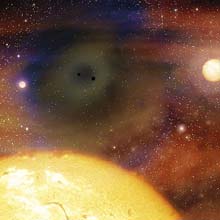This area deals with the fundamental laws and building blocks of nature and how they interact, the properties and the behavior of matter, and research into space and time and their structures.
innovations-report provides in-depth reports and articles on subjects such as astrophysics, laser technologies, nuclear, quantum, particle and solid-state physics, nanotechnologies, planetary research and findings (Mars, Venus) and developments related to the Hubble Telescope.

The instruments on board ESA’s mission to Mars, Mars Express, are in the process of being tested to verify that they have survived the launch successfully and will work properly. One of these tests on the Mars Express lander, Beagle 2, has been postponed to the first week of July.
This will give engineers extra time to investigate a temporary anomaly that occurred in a memory unit, the so-called “Solid State Mass Memory” (SSMM). The SSMM stores data from the instruments before sending t

With the help of ultrafast lasers, Dutch researcher Anouk Wetzels from the FOM Institute for Atomic and Molecular Physics has visualised the wave function of slow electrons. The wave function describes how the electron moves around the nucleus of an atom. With this it is possible to directly visualise atomic and even molecular wave functions.
Wetzels used light pulses with a duration of a millionth of a millionth of a second to visualise the wave function of electrons in atoms. With these

Clearest-Ever Evidence from VLT Spectra of Powerful Event
A very bright burst of gamma-rays was observed on March 29, 2003 by NASA’’s High Energy Transient Explorer (HETE-II), in a sky region within the constellation Leo.
Within 90 min, a new, very bright light source (the “optical afterglow”) was detected in the same direction by means of a 40-inch telescope at the Siding Spring Observatory (Australia) and also in Japan. The gamma-ray burst was designated GRB 030329, acco

First detection by infrared interferometry of an extragalactic object
Active galactic nuclei (AGN) are one of the most energetic and mysterious phenomena in the universe. In some galaxies indeed, the core generates amounts of energy which surpass those of normal galaxies, such as the Milky Way, by many orders of magnitude.
The central engine of these power stations is thought to be a supermassive black hole. Indirect lines of evidence have suggested that these massive black

NASA and university astronomers have found evidence the 11-year sunspot cycle is driven in part by a giant conveyor belt-like, circulating current within the Sun.
The astronomers, Dr. David Hathaway, Robert Wilson and Ed Reichmann of NASA’s Marshall Space Flight Center in Huntsville, Ala., and Dr. Dibyendu Nandy of Montana State University in Bozeman, reported their findings the week of June 16 at the annual meeting of the Solar Physics Division of the American Astronomical Soci

Using images from the Hubble Space Telescope, astronomers have concluded that two of the most common types of galaxies in the universe are in reality different versions of the same thing. In spite of their similar-sounding names, astronomers had long considered “dwarf elliptical” and “giant elliptical” galaxies to be distinct objects. The new findings, which appear in this month’s edition of The Astronomical Journal, fundamentally alter astronomers’ understanding of these important components of th